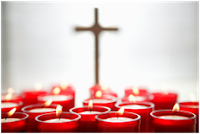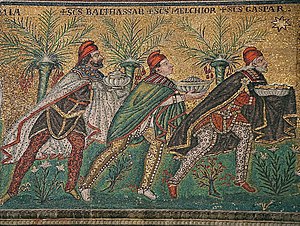Not surprisingly, many Catholics are asked to attend Mass to
celebrate the New Year, but this may depend on the local custom or your country
or your bishop. There are also some other
traditions for Catholics in the upcoming days. Recipes for some of the festive food can be found by following the enclosed links.
 New Year’s Eve coincides with the celebration of St.
Sylvester in Europe on the 31st. The festivities include merry-making
and the ringing of bells throughout the night. Although currently regarded as a
liturgical feast day, it is a reinvention of the pre-Christian traditions of
scaring away bad spirits to ensure good luck in the New Year. St. Sylvester’s
special celebration is the drinking and sharing of the punch bowl, which could
be non-alcoholic.
New Year’s Eve coincides with the celebration of St.
Sylvester in Europe on the 31st. The festivities include merry-making
and the ringing of bells throughout the night. Although currently regarded as a
liturgical feast day, it is a reinvention of the pre-Christian traditions of
scaring away bad spirits to ensure good luck in the New Year. St. Sylvester’s
special celebration is the drinking and sharing of the punch bowl, which could
be non-alcoholic.
New Year’s Day was originally entitled the Circumcision of the Lord
but is sometimes recognized instead as the Solemnity of Mary. It is a Holy Day of Obligation,
unless it falls on a Saturday or Monday. Many Catholics attend Mass on this
day. It is considered good luck to eat corned beef
and cabbage or lentils on this day.
In many countries, New Year’s Day is a renewal of baptism
and godparents are often honored with prayers and treats, such as God cakes,
which resemble fruit pastries. In many countries, parents are honored as well,
with children – of all ages - in places as different as China and Canada
wearing their best attire to greet their parents and offering thanksgiving for
their love and support throughout the past year.
In Europe, there is an association between beer and certain saints. St. Arnold of France is heralded as an advocate of beer consumption , and St. Brigid of Ireland was considered quite skilled in making ale and beer. This was likely due to the sewage-strewn drinking water of the cities. St. Arnold is credited with announcing that the hard work of man and the Love of God produced the beer of this world. There is also a prayer to bless beer, which is sometimes served as part of the New Year festivities.
Pope John II changed the Feast of the Holy Name of Jesus to
the January 3rd. This day commemorates the shedding of his blood,
the circumcision, and the giving of his name, Jesus, which means Savior. Sweets
and pastries such as God Cakes are also served.In Europe, there is an association between beer and certain saints. St. Arnold of France is heralded as an advocate of beer consumption , and St. Brigid of Ireland was considered quite skilled in making ale and beer. This was likely due to the sewage-strewn drinking water of the cities. St. Arnold is credited with announcing that the hard work of man and the Love of God produced the beer of this world. There is also a prayer to bless beer, which is sometimes served as part of the New Year festivities.
| Basilica of Sant'Apollinare Nuovo in Ravenna, Italy: The Three Wise Men" (named Balthasar, Melchior, and Gaspar). Detail from: "Mary and Child, surrounded by angels", mosaic of a Ravennate italian-byzantine workshop, completed within 526 AD by the so-called "Master of Sant'Apollinare". (Photo credit: Wikipedia) |
January 5th, the eve of the Epiphany or Feast of
the Magi, is commonly regarded as the the Twelfth Night of Christmas,
immortalized as part of a children’s carol from many ages ago. Interestingly,
many Catholic traditions are simply reinventions of originally pagan holidays.
For example, twelfth night was a celebration of the end of winter festival in
Medieval England, which started with All Hallow’s Eve (Hallowe’en). Cakes were
also served, and finding a bean within the cake meant you were king or queen of
the festivities until midnight. Shakespeare based his play, Twelfth Night, on these traditions. These
types of festivals date back to Ancient Rome and pre-Christian Europe. Although
the Epiphany is not often celebrated as largely as Christmas in the United
States, it is regarded as more
important than Christmas in many Eastern European churches.
January 6th is regarded as the Epiphany or the
Day of the Magi. There might be some confusion between fifth and the sixth but
the sixth is generally regarded as the Twelfth Day as opposed to the Twelfth Night. There is an Epiphany Cake, sometimes called a kings’cake, which is made with trinkets baked inside to symbolize different aspects
of the faith, such as a tiny bean to represent baby Jesus. The hidden baby is a
reminder that the baby Jesus had to be hidden from King Herod to avoid being
captured and killed. These days it is
more common to use a tiny toy baby rather than a bean. The kings’ cake can be served often, from
twelfth night all the way until Mardi Gras, the beginning of the Lenten Season.
This cake can be made of nearly any type of sweet cake, from
something resembling a giant cinnamon roll in New Orleans, La. to a puff pastry creation
in France or a marzipan-stuffed pastry in Catalonia or sweet bread with dried
and candied fruits in Spain and Mexico. The recipes all vary a bit, but in
general, their main similarities are that the cakes are typically round with a
hole in the middle (like a giant doughnut), there are trinkets hidden inside, and
they may be brightly colored. The round circle is said to be representative of
a crown. When the cake is prepared closer to Mardi Gras the cakes are typically
colored with gold, purple and green.
In some areas, a special Mass is celebrated with Holy Water,
a blessing of chalk, frankincense, myrrh and gold. Many people bring the gold (such as a
rosary or a ring), a container for the Epiphany Holy Water, and the chalk.
These items will be blessed as they are exposed during the Mass. The Holy Water
is taken home to
bless the home for the New Year, and the chalk is used to inscribe over
your front door special letters and numbers. The letters stand for the names of the three
Wise Men, Caspar, Melchior, and Balthasar. The four digit year is broken in
half, with the first two numbers before the letters, and the last two numbers
after the letters. For example, in 2014, it was “20 C+M+B 14”. In the 21st century, the first two
numbers will change to “21”. There is a special prayer that
is said, also, to bless the home for the New Year.
An “Epiphany Play” is a simple re-enactment of the Wise Men
visiting the baby Jesus and bringing gifts to him. If you have a Nativity scene
in or outside your home, children in your house can wear paper crowns and bring
handmade gifts to the baby, as part of a fun procession. Songs can be sung, and
the gifts can either be pretend or you can incorporate a charitable act by
presenting baby items that can be donated later to a children’s shelter or
charity. Afterwards, you can celebrate with cake and Lambs Wool – which is similar to a
cider-based eggnog - wassail, or a non-alcoholic, apple juice-based drink, like
Hot
Apple Pie.
The Sunday after the Epiphany is the Feast of the Holy
Family, where they are regarded as models of love and devotion for families
everywhere.









No comments:
Post a Comment